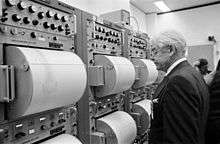Lunar seismology
Lunar seismology is the study of ground motions of the Moon and the events, typically impacts or moonquakes, that excite them.
.jpg)

History
Several seismographic measuring systems have already been installed on the Moon and their data made available to scientists (such as those from the Apollo Lunar Surface Experiments Package). The existence of moonquakes was an unexpected discovery from seismometers placed on the Moon by Apollo astronauts from 1969 through 1972. The instruments placed by the Apollo 12, 14, 15, and 16 missions were functional until they were switched off in 1977.[1] Moonquakes are not believed to be caused by tectonic plate movement (as earthquakes are), but by tidal forces between Earth and the Moon.[2] Further data hope to clarify the origins and effects of the forces causing moonquakes.
Major Findings
Moonquakes
Several categories of moonquakes were recorded. Hundreds of deep moonquakes were recorded along with 28 shallow events. The deeper quakes are caused by tidal forces with the Earth and tended to occur in clusters.[3][4] The shallow events have tectonic origins. Although more rare than deep events, the shallow events were larger, with body wave magnitudes > 5.5 and stress drops exceeding 100 MPa.[5] Other sources of seismic activity included meteorite impacts and artificial signals from lunar modules.
Structure of the Lunar Interior
One key finding was an improved understanding of the structure of the deep lunar interior, including the existence of a solid inner-core and sharp core-mantle boundary and a partial-melt layer at the base of the lunar mantle.[6][7][8][9] The solid core has a radius of about 240 km and is surrounded by a much thinner liquid outer core with a thickness of about 90 km.[7] The partial melt layer sits above the liquid outer core and has a thickness of about 150 km. The mantle extends to within 45 ± 5 km of the lunar surface.[9]
Limitations of the Current Dataset
- Scattering from the megaregolith Strong variations in material properties near the surface of the Moon, likely caused by a long history of impact cratering, are thought to be responsible for the complex seismic waveforms that lack clear reflected arrivals that would provide clear seismological evidence of a lunar core.
- Selenographical distribution All of the Apollo seismometers were placed on the near side of the Moon. The relative dearth of moonquakes observed on the far side of the Moon has been interpreted as either (1) evidence for an attenuating core or (2) observational bias given that it is easier to detect events of a fixed magnitude that are closer to the sensors.
Future plans
Due to the success of the Apollo seismometers, several space agencies including NASA have expressed interest in funding future seismic missions to the Moon. NASA's Planetary Science Decadal Survey for 2012-2022 [10] lists a lunar geophysical network as a recommended New Frontiers mission. The mission would be tasked with enhancing the knowledge of the lunar interior using several identical landers distributed over the lunar surface. A network of arrays would be able to better constrain lunar seismicity, especially on the far side of the Moon. In early 2018, NASA a new program called the Development and Advancement of Lunar Instrumentation (DALI).[11] The goal of DALI is to fund potential instruments so that they reach a technology readiness level of 6, meaning the instruments could be proposed for flight opportunities as early as 2023 and would not require significant technology development. DALI looks to fund instruments that would support the Science Mission Directorate's Planetary Science Division, including the desired lunar geophysical network. The due-date for proposals was in the Spring of 2018, and selected proposals were not announced as of September 2018.
References
- Goins, N. R.; et al. (June 10, 1981). "Lunar seismology – The internal structure of the moon". Journal of Geophysical Research. 86: 5061. Bibcode:1981JGR....86.5061G. doi:10.1029/JB086iB06p05061. hdl:2060/19790009611.
- Apollo 15 Mission. Lunar and Planetary Institute Retrieved 2012-02-12.
- Lammlein, David (June 1977). "Lunar seismicity and tectonics". Physics of the Earth and Planetary Interiors. 14 (3): 224–273. doi:10.1016/0031-9201(77)90175-3.
- Nakamura, Yosio; Latham, Gary; Dorman, H. James (15 November 1982). "Apollo Lunar Seismic Experiment- Final Summary". Journal of Geophysical Research: Solid Earth. 87 (S01): A117–A123. doi:10.1029/JB087iS01p0A117.
- Oberst, Jurgen (10 February 1987). "Unusually high stress drops associated with shallow moonquakes". Journal of Geophysical Research: Solid Earth. 92 (B2): 1397–1405. Bibcode:1987JGR....92.1397O. doi:10.1029/JB092iB02p01397.
- Lammlein, David R; Latham, Gary V; Dorman, James; Nakamura, Yosio; Ewing, Maurice (February 1977). "Lunar seismicity, structure, and tectonics". Reviews of Geophysics. 12 (1): 1–21. doi:10.1029/RG012i001p00001.
- Weber, Renee; Lin, Pei-Ying; Garnero, Edward J; Williams, Quentin; Lognonne, Philippe (21 January 2011). "Seismic Detection of the Lunar Core". Science. 331 (6015): 309–312. Bibcode:2011Sci...331..309W. doi:10.1126/science.1199375. PMID 21212323.
- Garcia, Raphael; Gagnepain-Beyneix, Jeannine; Chevrot, Sebastien; Lognonne, Philippe (September 2011). "Very preliminary reference Moon model". Physics of the Earth and Planetary Interiors. 188 (1–2): 96–113. doi:10.1016/j.pepi.2011.06.015.
- Khan, A; Mosegaard, K; Rasmussen, K L (1 June 2000). "A new seismic velocity model for the Moon from Monte Carlo inversion of the Apollo lunar seismic data". Geophysical Research Letters. 27 (11): 1591–1594. doi:10.1029/1999GL008452.
- Vision and Voyages for Planetary Science in the Decade 2013-2022. Washington DC: The National Academies Press. March 7, 2011. ISBN 978-0-309-22464-2.
- "NASA Research Announcement: Development and Advancement of Lunar Instrumentation Program". NSPIRES NASA Solicitation and Proposal Integrated Review and Evaluation System. NASA Research and Education Support Service. Retrieved 8 October 2018.
